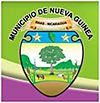Nueva Guinea facts for kids
Quick facts for kids
Nueva Guinea
|
||
|---|---|---|
|
Municipality
|
||

Preview of Nueva Guinea, RACCS
|
||
|
||
| Country | ||
| Autonomous Region | South Caribbean Coast Autonomous Region | |
| Municipality | Nueva Guinea | |
| Area | ||
| • Municipality | 2,677 km2 (1,034 sq mi) | |
| Elevation | 184 m (604 ft) | |
| Population
(2022 estimate)
|
||
| • Municipality | 79,610 | |
| • Density | 29.739/km2 (77.022/sq mi) | |
| • Urban | 40,278 | |
| Time zone | UTCGMT-6 | |
| Climate | Am | |
| Website | Nueva Guinea | |
Nueva Guinea is a town and a municipality in the South Caribbean Coast Autonomous Region of Nicaragua. It is a place with a rich history and unique natural features.
This town was started in the 1960s. It grew a lot in the early 1970s. The US Peace Corps helped families move here. They came from the Pacific part of Nicaragua. In return, they received free land and farming help.
In 1971, a volcano called Cerro Negro erupted. It was about 20 km east of Leon, Nicaragua. Ash fell heavily, damaging much farmland. The US government and Nicaragua worked together to help. They moved about 1000 families to Nueva Guinea. This was a big help for the community.
US Air Force planes helped with the move. They landed on a simple dirt runway. A bulldozer was even flown in to make the runway safer. Local children often watched the planes land and take off. This big move was very important for Nueva Guinea. At that time, the town had limited electricity. Roads were often only usable in the dry season.
Contents
Geography and Location
Nueva Guinea is a municipality in Nicaragua. It shares its borders with several other areas. To the north, it borders Bullocks Wharf and El Rama. To the south, it borders San Carlos, El Castillo, and Bluefields.
To the east, it borders El Rama and Bluefields. To the west, it borders El Almendro, Villa Sandino, and San Miguelito. The main town is about 292 km from Managua, the capital city. The town is partly divided by the mountains of the Cordillera de Yolaina.
Nature and Climate
Nueva Guinea has a tropical monsoon climate. This means it is warm all year round. It also has a lot of rain during certain months. The average rainfall each year is about 2,245 millimeters.
The land here is made of old volcanic rock. On top of this, there is a thick layer of red clay. This clay layer can be 50 to 60 feet deep. Below the clay, there is often gravel. The soil in this area is not very fertile.
Towns and Organization
Nueva Guinea has a special way of organizing its areas. The main town is surrounded by five districts. These districts are called Talolinga, Naciones Unidas, La Fonseca, La Union, and Nueva Guinea.
Each district has several smaller areas called colonies. These colonies can have anywhere from two to twelve parts. The colonies are then divided into even smaller areas. This system helps manage the land and communities.
Economy and Farming
The main way people make a living in Nueva Guinea is through farming. They grow many different crops. These include quequisque, cassava, taro, and bananas. They also grow tomatoes, rice, beans, and corn.
People also raise livestock, like cows and pigs. This meat is mostly for local use and for Nicaragua. The land here is not very fertile for farming for a long time. So, farmers often clear more forest to find new land. This can lead to forests disappearing over time.
Nueva Guinea is one of the most developed municipalities in Nicaragua. However, this growth relies on farming methods that might not be good for the tropical forests in the long run.
History of Nueva Guinea
People have lived in this area for a very long time. Near the Punta Gorda River, scientists found remains of an ancient civilization. They built circular structures. Pottery found there is about 3000 to 4000 years old.
In the early 1900s, people started to settle here. They began clearing the jungle. After 1950, more people moved to the area. They came for activities like collecting rubber and cutting wood.
Universities in the Area
Nueva Guinea is home to several universities. These schools help educate young people in the region. They offer different programs for students.
The universities include:
- University of the Autonomous Regions of the Nicaraguan Caribbean Coast (URACCAN)
- University of the Assemblies of God, Martin Luther (UML)
- West University (UDO)
- Agricultural Technical Education Center (CETA / INATEC)
International Connections
Nueva Guinea has connections with cities in other countries. These are called "twin towns" or "sister cities." They help build friendships and cultural exchange.
Twin Towns
Nueva Guinea is twinned with:
 Sint-Truiden, Belgium
Sint-Truiden, Belgium
See also
 In Spanish: Nueva Guinea (Nicaragua) para niños
In Spanish: Nueva Guinea (Nicaragua) para niños



